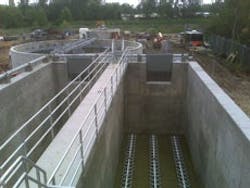Wastewater Plant Expansion Enables Economic Development
| Related Searches from WaterInfoLink.com Arcola, Texas | Headworks | Layne Christensen | Treatment Plants | Brown and Gay Engineering |
For many years, the city of Arcola, Texas, had managed its wastewater efficiently. With just more than 1,000 residents, all that was required was a small racetrack-style activated sludge wastewater treatment plant that the city constructed in the early 1980s. The plant had a design capacity of 0.125 million gal per day (mgd), and for more than twenty-five years that was more than enough. However, the plant was not designed to accommodate the demands of a rapidly growing population. New communities were developing, spurred in part by the completion of Texas Highway 6, which passed through the center of the town.
With years of experience in the construction of both large-scale wastewater treatment plants and smaller package plants , Layne Christensen Co. won a competitive bid from Brown and Gay Engineering to serve as the general contractor, providing both construction and fabrication services.
Using a design provided by Lindsey Kovar, project engineer for Brown and Gay Engineering, Layne’s Senior Project Manager Mike Moreno and Layne Project Manager Dean Wilburn began construction in February 2009 with a targeted completion date of Jan. 21, 2010. New construction includes a headworks, an in-ground 72-by-36-by-19-ft concrete aeration basin, a clarifier, a sludge pump, a chlorine basin and all supporting piping. To economize, components of the original facility have been given a new life through redesign. The original racetrack-style plant has been reconfigured as a digester with coarse air diffusion, and the original clarifier has now been repurposed as a thickener.
The new plant has many performance-enhancing features. The new headworks features an automated grit remover and a mechanical bar screen with sensor-activated rake and auger. Fine air diffusers improve the efficiency of both the aeration basin and the chlorine basin. Layne was also able to use its own in-house fabrication capabilities to supply all stairways and air headers.
The new plant uses the activated sludge process to produce effluent meeting less than 10 mg/L biological oxygen demand and less than 15 mg/L total suspended solids. Compliant effluent is then discharged to surface waters. Future plans for expansion will provide redundancy to aid maintenance while doubling overall plant capacity to 1 mgd.
Those attending WEFTEC in Orlando can find out more about treatment options from Layne Christensen by visiting booth #4369.
